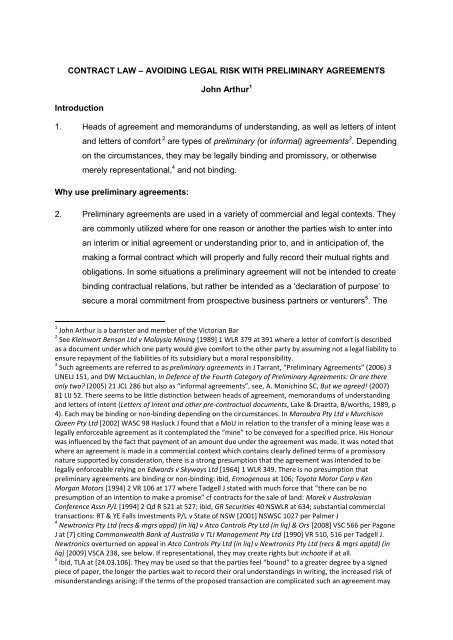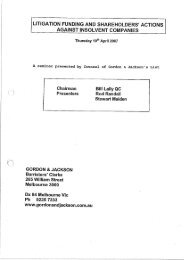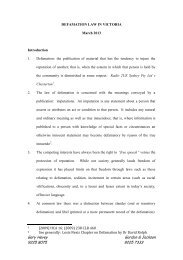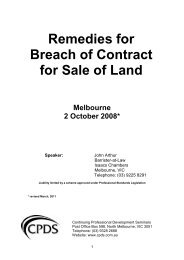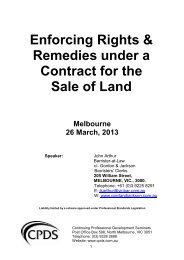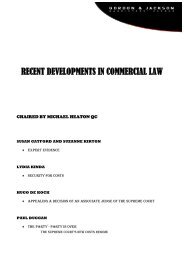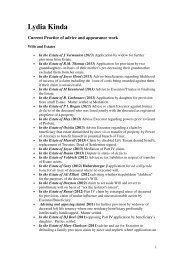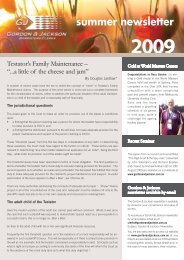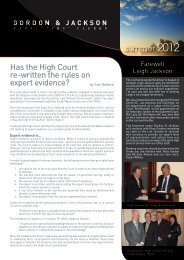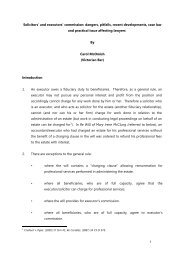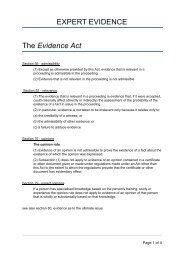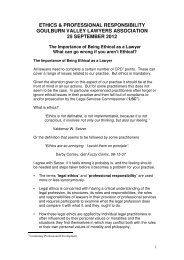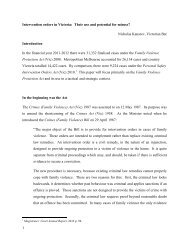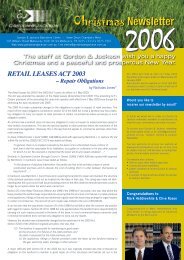CONTRACT LAW – AVOIDING LEGAL RISK WITH PRELIMINARY ...
CONTRACT LAW – AVOIDING LEGAL RISK WITH PRELIMINARY ...
CONTRACT LAW – AVOIDING LEGAL RISK WITH PRELIMINARY ...
You also want an ePaper? Increase the reach of your titles
YUMPU automatically turns print PDFs into web optimized ePapers that Google loves.
<strong>CONTRACT</strong> <strong>LAW</strong> <strong>–</strong> <strong>AVOIDING</strong> <strong>LEGAL</strong> <strong>RISK</strong> <strong>WITH</strong> <strong>PRELIMINARY</strong> AGREEMENTS<br />
John Arthur 1<br />
Introduction<br />
1. Heads of agreement and memorandums of understanding, as well as letters of intent<br />
and letters of comfort 2 are types of preliminary (or informal) agreements 3 . Depending<br />
on the circumstances, they may be legally binding and promissory, or otherwise<br />
merely representational, 4 and not binding.<br />
Why use preliminary agreements:<br />
2. Preliminary agreements are used in a variety of commercial and legal contexts. They<br />
are commonly utilized where for one reason or another the parties wish to enter into<br />
an interim or initial agreement or understanding prior to, and in anticipation of, the<br />
making a formal contract which will properly and fully record their mutual rights and<br />
obligations. In some situations a preliminary agreement will not be intended to create<br />
binding contractual relations, but rather be intended as a ‘declaration of purpose’ to<br />
secure a moral commitment from prospective business partners or venturers 5 . The<br />
1 John Arthur is a barrister and member of the Victorian Bar<br />
2 See Kleinwort Benson Ltd v Malaysia Mining [1989] 1 WLR 379 at 391 where a letter of comfort is described<br />
as a document under which one party would give comfort to the other party by assuming not a legal liability to<br />
ensure repayment of the liabilities of its subsidiary but a moral responsibility.<br />
3 Such agreements are referred to as preliminary agreements in J Tarrant, “Preliminary Agreements” (2006) 3<br />
UNELJ 151, and DW McLauchlan, In Defence of the Fourth Category of Preliminary Agreements: Or are there<br />
only two? (2005) 21 JCL 286 but also as “informal agreements”, see, A. Monichino SC, But we agreed! (2007)<br />
81 LIJ 52. There seems to be little distinction between heads of agreement, memorandums of understanding<br />
and letters of intent (Letters of Intent and other pre-contractual documents, Lake & Draetta, B/worths, 1989, p<br />
4). Each may be binding or non-binding depending on the circumstances. In Maroubra Pty Ltd v Murchison<br />
Queen Pty Ltd [2002] WASC 98 Hasluck J found that a MoU in relation to the transfer of a mining lease was a<br />
legally enforceable agreement as it contemplated the “mine” to be conveyed for a specified price. His Honour<br />
was influenced by the fact that payment of an amount due under the agreement was made. It was noted that<br />
where an agreement is made in a commercial context which contains clearly defined terms of a promissory<br />
nature supported by consideration, there is a strong presumption that the agreement was intended to be<br />
legally enforceable relying on Edwards v Skyways Ltd [1964] 1 WLR 349. There is no presumption that<br />
preliminary agreements are binding or non-binding: ibid, Ermogenous at 106; Toyota Motor Corp v Ken<br />
Morgan Motors [1994] 2 VR 106 at 177 where Tadgell J stated with much force that “there can be no<br />
presumption of an intention to make a promise” cf contracts for the sale of land: Marek v Australasian<br />
Conference Assn P/L [1994] 2 Qd R 521 at 527; ibid, GR Securities 40 NSWLR at 634; substantial commercial<br />
transactions: RT & YE Falls Investments P/L v State of NSW [2001] NSWSC 1027 per Palmer J<br />
4 Newtronics Pty Ltd (recs & mgrs appd) (in liq) v Atco Controls Pty Ltd (in liq) & Ors [2008] VSC 566 per Pagone<br />
J at [7] citing Commonwealth Bank of Australia v TLI Management Pty Ltd [1990] VR 510, 516 per Tadgell J.<br />
Newtronics overturned on appeal in Atco Controls Pty Ltd (in liq) v Newtronics Pty Ltd (recs & mgrs apptd) (in<br />
liq) [2009] VSCA 238, see below. If representational, they may create rights but inchoate if at all.<br />
5 ibid, TLA at [24.03.106]. They may be used so that the parties feel “bound” to a greater degree by a signed<br />
piece of paper, the longer the parties wait to record their oral understandings in writing, the increased risk of<br />
misunderstandings arising; if the terms of the proposed transaction are complicated such an agreement may
2<br />
parties may include a confidentiality clause to aid negotiation without disclosing<br />
commercial secrets, even if no binding contractual arrangements are entered into. In<br />
this sort of situation, while no binding contractual arrangements are intended, the<br />
binding nature of the confidentiality clause is required. A negotiation may have<br />
reached a point where the parties wish to record their agreement to that point,<br />
despite other points remaining at issue 6 . A preliminary agreement may give the<br />
parties comfort and impetus for them to move towards concluding their bargain 7 .<br />
3. Preliminary agreements have proven to be a useful tool in commercial life for lawyers<br />
and business people alike 8 . Used sensibly they will assist commercial parties in<br />
reaching, and recording, a preliminary consensus, but used badly, or in an<br />
haphazard or ill-informed fashion, they can create difficulties. If the parties are<br />
ambivalent or ambiguous in their communications, problems may easily arise. Unless<br />
great care is taken to properly record the parties’ true intentions (and even if this<br />
occurs), a risk of difficulty and dispute may arise.<br />
4. The cases are legion in which the binding nature of preliminary agreements is at<br />
issue. One academic suggests that disputes about the enforceability of preliminary<br />
commercial agreements are second only to interpretation disputes as the most<br />
litigated cases in Australia and New Zealand 9 . One may query whether parties would<br />
be better off waiting for a short period for their lawyers to draw up a formal contract<br />
which may save the parties from litigation, rather than utilizing a preliminary<br />
agreement unaided by legal advice and assistance. Commercially however, the<br />
parties may purposefully wish to leave the preliminary agreement vague, ambivalent<br />
or ambiguous so that each has an “out” or an “in” depending on what subsequent<br />
give each party comfort that a meeting of the minds has taken place; the letter might convince a third party, or<br />
someone within the organisation that the contemplated deal is viable; and it may serve as an aide memoire for<br />
the draftsperson who will draft the formal contract: see, “Letters of Intent <strong>–</strong> Are they worth it”, R Macey,<br />
(2004) 78 LIJ (No 3) 60-63.<br />
6 See, J Tarrant, Preliminary Agreements (2006) 3 UNELJ 151 at 155-156<br />
7 ibid<br />
8 It is suggested that the letter of intent or heads of agreement is the preferred option for international joint<br />
venturers in the negotiation phase by which a statement of operating principles between the participants is<br />
obtained which is subsequently supplemented by a detailed joint venture agreement, The Laws of Australia,<br />
Thomson (TLA) at [24.03.106]<br />
9 DW McLauchlan, In Defence of the Fourth Category of Preliminary Agreements: Or are there only two? (2005)<br />
21 JCL 286, p 287
3<br />
events occur 10 . If this occurs, the resolution of such ambiguity may require detailed<br />
factual and legal analysis 11 .<br />
Problems may arise if the parties’ intentions are not made clear:<br />
5. The true nature of a preliminary agreement and whether or not it is intended to<br />
constitute a concluded contract is critical. A variety of problems can arise if the<br />
parties’ intentions are not made perfectly clear.<br />
Australian Securities and Investments Commission v Fortescue Metals Group Ltd<br />
6. In the well known recent case of Forrest v Australian Securities and Investments<br />
Commission 12 the High Court overturned the decision of the Full Federal Court in<br />
Australian Securities and Investments Commission (ASIC) v Fortescue Metals Group<br />
Ltd (FMG) 13 , which had found that FMG had engaged in misleading and deceptive<br />
conduct under s. 52 Trade Practices Act 1974 (Cth) 14 and s. 1041H Corporations Act<br />
2001 (Cth) 15 (and FMG’s chairman and CEO was a person involved in the<br />
contravention), in making various public announcements that FMG had executed<br />
binding agreements with Chinese contractors to build, finance and transfer the<br />
infrastructure for a mining project in the Pilbara in Western Australia. The Full<br />
Federal Court had found that the framework agreements were merely ‘agreements to<br />
agree’ with many crucial matters left to be worked out between the parties. While the<br />
subjective intentions of the parties may have been to enter into a binding agreement<br />
to build the infrastructure, the crucial question was whether such a contract was<br />
actually made which involved taking an objective view of the agreement 16 . The<br />
contents of the agreements as to subject matter, scheduling and price were<br />
expressly left to be agreed 17 , such that the agreements contemplated the execution<br />
of further agreements and were not considered objectively binding.<br />
10 ibid, Tarrant at p. 156<br />
11 See, Geebung Investments P/L v Varga Group Investments No 8 P/L (1995) Aust Contract R 90-059; (1995) 7<br />
BPR 14,551, 14552 per Gleeson CJ cited in Factory 5 Pty Ltd (In Liq) v State of Victoria (No 2) [2012] FCAFC 150<br />
at [65]<br />
12 (2012) 291 ALR 399; (2012) 86 ALJR 1183; (2012) 91 ACSR 128; [2012] HCA 39 <strong>–</strong> handed down by the High<br />
Court on 2 October, 2012<br />
13 (2011) 190 FCR 364; (2011) 274 ALR 731; (2011) 81 ACSR 563; [2011] FCAFC 19<br />
14 Now s. 18 Australian Consumer Law which is Sched. 2 to the Competition and Consumer Act 2010 (Cth.)<br />
which is what the Trade Practices Act 1974 (Cth.) has been renamed.<br />
15 As a result it was found that FMG had contravened as well the continuous disclosure requirements of s. 674<br />
Corporations Act and Mr Forrest had not exercised his powers or discharged his duties as a director of FMG<br />
with the care and diligence required under s. 180(1) Corporations Act.<br />
16 Keane CJ at FCR 409<br />
17 By the express terms of the framework agreements, the parties would seek to reach agreement on these<br />
matters: ibid Keane CJ at 411
4<br />
7. The majority in the High Court 18 held that the impugned statements were not<br />
misleading or deceptive or likely to mislead or deceive, and as such the other<br />
allegations that ASIC made 19 dropped away as well. The impugned statements<br />
conveyed to the intended audience (that is, both present and possible future<br />
investors, or perhaps a wider section of the commercial or business or commercial<br />
community) what the parties to the agreements understood that they had done and<br />
intended would happen in the future <strong>–</strong> specifically that the parties had made<br />
agreements and what the parties to the framework agreements had said in those<br />
agreements and that those parties intended their agreements to be legally binding.<br />
Heydon J held that the impugned statement about the contract being binding was a<br />
statement of opinion rather than fact and ASIC failed because it did not establish that<br />
FMG did not genuinely and reasonably hold that opinion.<br />
8. The context within which this case arose was not inter partes litigation with one party<br />
seeking to enforce a preliminary agreement against the other, but a prosecution<br />
brought by ASIC pursuant to the Corporations Act acting under its statutory powers<br />
alleging that FMG and its chairman and CEO had engaged in misleading and<br />
deceptive conduct, and other infractions of the Corporations Act. It may be suggested<br />
that different tests will apply depending on the context.<br />
Newtronics Pty Ltd (recs & mgrs appd) (in liq) v Atco Controls Pty Ltd (in liq) & Ors;<br />
Atco Controls Pty Ltd (in liq) v Newtronics Pty Ltd (recs & mgrs apptd) (in liq)<br />
9. In another case a letter of comfort or support was given by one company (Atco) in<br />
relation to its subsidiary (Newtronics) to the effect that Atco would not call up the<br />
amount owing by Newtronics to Atco and if necessary funds or additional bank<br />
security would be provided to Newtronics or its financier to ensure that it could meet<br />
its current trading obligations that had or would be incurred. The primary judge held<br />
that the terms of a binding and enforceable contract could be found in the letters of<br />
support and gave judgment for Newtronics against Atco 20 . The primary judge’s<br />
decision was overturned on appeal 21 , the Court of Appeal holding that a non-binding<br />
commercial arrangement, rather than a legally binding agreement existed. The acid<br />
test was <strong>–</strong> “whether viewed as a whole and objectively from the point of view of<br />
18 French CJ, Gummow, Hayne and Kiefel JJ<br />
19 As referred to in note 12<br />
20 Newtronics Pty Ltd (recs & mgrs appd) (in liq) v Atco Controls Pty Ltd (in liq) & Ors [2008] VSC 566<br />
21 in Atco Controls Pty Ltd (in liq) v Newtronics Pty Ltd (recs & mgrs apptd) (in liq) [2009] VSCA 238
5<br />
reasonable persons on both sides, the dealings show a concluded bargain” 22 . There<br />
was no intention to create legal relations and the support was never intended to be<br />
legally binding 23 . There was an absence of good consideration and a debenture by<br />
Newtronics in favour of Atco was inconsistent with the binding agreement to be<br />
inferred.<br />
Whether the preliminary agreement is binding<br />
10. The critical question which arises in cases where the parties have decided to enter<br />
into a preliminary agreement before entering into a formal contract will be whether<br />
the preliminary agreement is a binding contractual arrangement. The intention to<br />
enter into such an agreement is the “decisive issue” 24 . The determination of this issue<br />
may be articulated as: did the parties reach a consensus? If they did, was it capable<br />
of forming a binding contract? If it was, did the parties intend it to constitute a binding<br />
contract? 25 Such intention will be objectively ascertained having regard to the<br />
communications between the parties and the circumstances in which they took<br />
place 26 .<br />
11. According to one commentator, in modern times the courts have been more likely to<br />
seek to fill in gaps in preliminary agreements so that they may be enforced but will<br />
not fill in gaps in incomplete agreements 27 , or where the gap is too wide to be filled 28 .<br />
It is clear that an incomplete agreement or a mere agreement to agree is not legally<br />
22 Vroon BV v Fosters Brewing Group Ltd [1994] 2 VR 32 per Ormiston J at p. 81 referring to what was said by<br />
Cooke J in Meates v AG [1983] NZLR 308, 377)(referred to in Atco at [34]<br />
23 Atco at [57]-[58]<br />
24 GR Securities P/L v Baulkham Hills Private Hospital P/L (1986) 40 NSWLR 631 at 634E cited in Bagot v<br />
Chameleon Mining NL [2012] NSWSC 1331 at [57]<br />
25 Air Great Lakes Pty Ltd v KS Easter (Holdings) Pty Ltd (1985) 2 NSWLR 309 at 326G referred to in Bagot, ibid<br />
as “a convenient template” at [61]<br />
26 Brambles Holdings v Bathurst City Council [201] NSWCA 61; (2001] 53 NSWLR 153 at [25] per Heydon JA; ABC<br />
v XIVTH Commonwealth Games Ltd (1988) 18 NSWLR 540 Gleeson CJ (Hope and Mahoney JJA agreeing) at pp<br />
548-549; Guilfoyle Developments Pty Ltd v Geoffrey Craig Frumar [2012] NSWSC 859 at [46]-[47]; Ermogenous<br />
v Greek Orthodox Community of SA Inc (2002) 209 CLR 95 at [25]. Whether or not a preliminary agreement or<br />
any other contract constitutes a binding contract is a question of fact and the plaintiff has the burden of<br />
persuading the court that such an agreement exists: Wesfarmers Bunnings Ltd v Angus & Robertson Bookworld<br />
P/L [1998] VSC 101 at [45] per Gillard J<br />
27 Booker Industries P/L v Wilson Parking (QLD) P/L (1982) 149 CLR 600 at 604 recently cited in Factory 5 Pty Ltd<br />
(In Liq) v State of Victoria (No 2) [2012] FCAFC 150 at [60]; ibid, J Tarrant at p. 183 citing Kirby P in Coal Cliff<br />
Collieries, ibid at p. 20: “Courts are not well equipped, drawing on their own experience, to fill out the detail of<br />
such contracts where the parties leave gaps in their own agreement ...Courts cannot enforce such agreements<br />
because they are incapable of judging where the negotiation on particular points would have taken the<br />
parties”. Incomplete agreements mean that essential terms are lacking<br />
28 Fletcher Challenge Energy Ltd v Electricity Corporation of New Zealand [2002] 2 NZLR 433 at 447; see J<br />
Tarrant at pp 184-185
6<br />
enforceable 29 , nor is an agreement to negotiate, at least unless it is clearly and<br />
unequivocally expressed 30 . The Courts will strive to uphold bargains and to that end<br />
will be inclined to construe the terms of an agreement, by applying objective<br />
standards of reasonableness and express machinery, and implying terms to give<br />
efficacy to the bargain, to give effect to the parties’ intentions even if that intention<br />
has been obscurely expressed 31 . In a suitable case an estoppel by conduct may be<br />
able to be relied upon precluding denial of the contract’s existence 32 , or where there<br />
is no contract in existence, restitutionary or other remedies may still be available 33 .<br />
Completeness/certainty and intention to be bound<br />
12. The approach taken by the Courts to determine whether a preliminary agreement<br />
constitutes a binding contractual arrangement is two-fold 34 : first, whether, as a matter<br />
of construction, the alleged agreement constitutes a binding contract, or only a basis<br />
for negotiation of a contract; and secondly, whether the parties intended to be<br />
immediately bound by the terms agreed. The question is whether “viewed as a whole<br />
and objectively from the point of view of reasonable persons on both sides, the<br />
dealings show a concluded bargain” 35 .<br />
13. The first issue to be determined is whether there has been a “voluntary assumption<br />
of a legally enforceable duty” (which is the essence of contract) 36 . For such a duty to<br />
arise all the essentials for a contract in the particular case must be present, including,<br />
that the parties must be identified, the terms must be certain, and there must<br />
29 Booker Industries Pty Ltd v Wilson Parking (Qld) Pty Ltd (1982) 149 CLR 600 at 604; Fortescue Metals (2011)<br />
190 FCR 364; (2011) 274 ALR 731; (2011) 81 ACSR 563; [2011] FCAFC 19 at [121]-[123] per Keane CJ<br />
30 Fortescue Metals (2011) 190 FCR 364; (2011) 274 ALR 731; (2011) 81 ACSR 563; [2011] FCAFC 19 at [121]-<br />
[123] per Keane CJ<br />
31 Fortescue Metals at [121]-[123] per Keane CJ. Courts may be more willing to uphold preliminary or informal<br />
agreements to settle litigation: See A. Monichino SC, But we agreed! (2007) 81 LIJ 52<br />
32 Thompson v Palmer [1933] HCA61; (1933) 49 CLR 507; 546-7 per Dixon J; Grundt v Great Boulder Pty Gold<br />
Mines [1937] HCA 58; (1937) 59 CLR 641 at 656-7 per Latham CJ; 674-6 per Dixon J; PRA Electrical Pty Ltd v<br />
Perseverance Exploration Pty Ltd (2007) 20 VR 487; [2007] VSCA 310 per Nettle JA at [7]; in Skilled Group Ltd v<br />
CSR Viridian Pty Ltd [2012] VSC 290 at [173]-[175] per Vickery adopting Nettle JA’s approach in PRA Electrical<br />
(obiter as it had been held that the subcontracts in issue were in existence)<br />
33 Pavey & Matthews v Paul (1987) 162 CLR 221; 256; Sabemo Pty Ltd v North Sydney Municipal Council<br />
[1977] 2 NSWLR 880 Angelopoulos and Anor v Sabatino and Anor (1995-6) 65 SASR 1; Andrew Shelton & Co Pty<br />
Ltd v Alpha Healthcare Ltd [2002] VSC 248 at [95<strong>–</strong>107]; ibid, Skilled Group Ltd at [178]. Remedies under s. 18<br />
Australian Consumer Law may be available.<br />
34 Masters v Cameron (1954) 91 CLR 353; 360<br />
35 Vroon BV v Foster’s Brewing Group Ltd at 82, citing Meates v Attorney-General [1983] NZLR 308 at 377 per<br />
Cooke J, and see Ormwave Pty Ltd v Smith (2007) 5 DDCR 180 at 195<strong>–</strong>6 ; [2007] NSWCA 210 at [70]<strong>–</strong>[76] per<br />
Beazley JA cited in PRA Electrical Pty Ltd v Perseverance Exploration Pty Ltd (2007) 20 VR 487; [2007] VSCA 310<br />
per Nettle JA at [6]<br />
36 Ermogenous v Greek Orthodox Community of SA Inc [2002] 209 CLR 95 at [24]; [2002] HCA 8; 76 ALJR 465;<br />
187 ALR 92; Maroubra Pty Ltd v Murchison Queen Pty Ltd [2002] WASC 98 at [59]
7<br />
generally be consideration 37 . Yet despite the existence of these matters, the<br />
circumstances may show that the parties did not intend or cannot be regarded as<br />
having intended for their agreement to be binding 38 .<br />
14. In determining the second issue, ”intention”, as has been noted is the case generally<br />
in contractual contexts, is determined in the sense that “(i)t describes what it is that<br />
would objectively be conveyed by what was said or done, having regard to the<br />
circumstances in which those statements and actions happened” 39 .<br />
15. In Masters v Cameron 40 , the locus classicus in relation to the enforceability of<br />
preliminary agreements, the High Court identified three categories of preliminary<br />
agreements. To these may be added a fourth category identified in Sinclair’s case 41<br />
and resurrected by McLelland J in Baulkham Hills Private Hospital Pty Ltd v GR<br />
Securities Pty Ltd 42 and now also universally accepted.<br />
16. In Masters v Cameron, in a passage which has been influential in Australian<br />
jurisprudence, the majority identified three categories of preliminary agreement<br />
where the parties who had been negotiating achieve agreement upon terms of a<br />
contractual nature agreeing that the subject of their negotiation should be dealt with<br />
by a formal contract, as follows (material in parenthesis added) 43 :<br />
(1.) It may be one in which the parties have reached finality in arranging all the<br />
terms of their bargain and intend to be immediately bound to the performance<br />
of those terms, but at the same time propose to have the terms restated in a<br />
form which will be fuller or more precise but not different in effect.(binding)<br />
37 unless the agreement is recorded as a deed: Ermogenous at [24]; see Skilled Group Ltd v CSR Viridian Pty Ltd<br />
[2012] VSC 290 at [165] where Vickery J stated that generally only three matters are regarded as essential, viz<br />
agreement on parties, subject matter and consideration and price but other matters may also be regarded as<br />
essential in the circumstances of the case<br />
38 ibid, Ermogenous at [25]<br />
39 ibid, Ermogenous at CLR pp105-6<br />
40 Masters v Cameron (1954) 91 CLR 353; (1954) 28 ALJR 438. The facts were that by a document a vendor<br />
agreed to sell farming land to a purchaser “subject to the preparation of a formal contract of sale which shall<br />
be acceptable to my solicitors on the above terms and conditions” and the purchaser agreed to purchase the<br />
property “on the above terms and conditions”. It was held that the document did not constitute a binding<br />
contract. The Court looked at the authorities which showed that “subject to contract” makes it clear that<br />
neither of the parties is to be contractually bound until a contract is signed. Although the formal contract was<br />
to be “on the above terms and conditions” it was to be acceptable to the vendor’s solicitors, meaning not only<br />
those terms already stated but whatever else the solicitors thought appropriate. The document was not<br />
binding<br />
41 Sinclair Scott & Co Ltd v Naughton (1929) 43 CLR 310<br />
42 (1986) 40 NSWLR 622 at 628 where the words “agreement in principle” did not prevail over the clear import<br />
of the words “legally binding”, which case was affirmed on appeal in GR Securities Pty Ltd v Baulkham Hills<br />
Private Hospital Pty Ltd (1986) 40 NSWLR 631<br />
43 at 360-362
8<br />
(2.) Or, secondly, it may be a case in which the parties have completely agreed<br />
upon all the terms of their bargain and intend no departure from or addition to<br />
that which their agreed terms express or imply, but nevertheless have made<br />
performance of one or more of the terms conditional upon the execution of a<br />
formal document. (binding but performance of terms conditional upon<br />
execution of formal contract)<br />
(3.) Or, thirdly, the case may be one in which the intention of the parties is not to<br />
make a concluded bargain at all, unless and until they execute a formal<br />
contract. (not binding)<br />
In each of the first two cases there is a binding contract: in the first case a<br />
contract binding the parties at once to perform the agreed terms whether the<br />
contemplated formal document comes into existence or not, and to join (if<br />
they have so agreed) in settling and executing the formal document; and in<br />
the second case a contract binding the parties to join in bringing the formal<br />
contract into existence and then to carry it into execution. Of these two cases<br />
the first is the more common...<br />
Cases of the third class 44 are fundamentally different. They are cases in which<br />
the terms of agreement are not intended to have, and therefore do not have,<br />
any binding effect of their own ... The parties may have so provided either<br />
because they have dealt only with major matters and contemplate that others<br />
will or may be regulated by provisions to be introduced into the formal<br />
document ... or simply because they wish to reserve to themselves a right to<br />
withdraw at any time until the formal document is signed.<br />
17. A fourth category identified is where the parties are “content to be bound immediately<br />
and exclusively by the terms which they have agreed upon whilst expecting to make<br />
a further contract in substitution for the first contract, containing, by consent,<br />
additional terms” 45 . Again, into which category an agreement will fall will depend on<br />
the intention of the parties objectively ascertained 46 .<br />
44 eg ibid, Factory 5 P/L (in liq) at [104](k) per Foster J<br />
45 Sinclair, Scott & Co Ltd v Naughton (1929) 43 CLR 310 at 317 per Knox CJ, Rich and Dixon JJ; the fourth<br />
category was restated by McLelland J in Baulkham Hills Private Hospital Pty Ltd v GR Securities Pty Ltd (1986)<br />
40 NSWLR 622 at 628 and affirmed on appeal in GR Securities Pty Ltd v Baulkham Hills Private Hospital Pty Ltd<br />
(1986) 40 NSWLR 631; also referred to in ibid, Tarrant at 157-158 and referring to Peden, Carter and Tolhurst<br />
When Three Just Isn’t Enough: the Fourth Category of the ‘Subject to Contract Cases’ (2004) 20 JCL 156, Young<br />
CJ in Helmos Enterprises Pty Ltd v Jaylor Pty Ltd Helmos Enterprises Pty Ltd v Jaylor Pty Ltd (2005) 12 BPR<br />
23,021; (2005) Aust Contract R 90-215; [2005] NSWCA 235 stated at [69] that “an article by academics which<br />
attacks the considered view of MH McLelland J, one of the greatest equity judges of the 20th century, in a<br />
decision which was upheld in the Court of Appeal and since followed by almost every judge of the Court of<br />
Appeal and the Equity Division, as not being of any authority and contrary to what the High Court said in<br />
Masters v Cameron, does not rate serious consideration”. See also ibid, DW McLachlan which discusses this<br />
issue. In Skilled Group Ltd v CSR Viridian Pty Ltd [2012] VSC 290 at [106]-[107], [117] Vickery J held that the<br />
parties in that case had reached an agreement in the nature of the fourth category of preliminary agreement.<br />
In Uranium Equities Ltd v Fewster (2008) 36 WAR 97; [2008] WASCA 33 at [129] stated that the fourth category<br />
is a variation of the first category<br />
46 Masters v Cameron at 362
9<br />
18. One academic has suggested that there are in fact only two categories of cases, and<br />
the law would be easier to understand if this was recognised 47 . Those categories are<br />
first, agreements which are intended to be binding and are sufficiently complete (the<br />
current first, second and fourth categories), and agreements which are not intended<br />
to be binding or that are not sufficiently complete (which is the current third category).<br />
The factors for determining whether a preliminary agreement is binding?<br />
19. If the enforceability of a preliminary agreement is at issue, what are the determinative<br />
factors? It is suggested 48 the main factors in determining whether a preliminary<br />
agreement is binding are as follows:<br />
(a)<br />
(b)<br />
the parties must intend in entering the preliminary agreement to be<br />
immediately bound pending execution of the anticipated formal contract. Such<br />
intention is to be ascertained objectively by “consider(ing) what reasonable<br />
persons in the position of the parties would have understood to mean by<br />
reference to the text of the agreement, the surrounding circumstances known<br />
to the parties and the purpose or object of the transaction” 49 ;<br />
the main factor to consider is the language used by the parties in the<br />
agreement for if this is clear and conclusive, the court may not need to look<br />
further 50 . If the language is ambiguous 51 , then the other factors referred to in<br />
(c)-(f) below will be relevant;<br />
47 ibid, DW McLauchlan<br />
48 Adapted, and derived, from the suggested summary of the main principles in DW McLachlan ibid at p. 305,<br />
as well as the cases including Fortescue Metals at [121]-[123], [131]-[132] per Keane CJ and those others noted<br />
49 Everest Project Developments Pty Ltd v Mendoza & Ors [2008] VSC 366 per Hargrave J at [65] and cases<br />
there cited including Pacific Carriers Ltd v BNP Paribas [2004] HCA 35; (2004) 218 CLR 451, [22]; Toll (FGCT) Pty<br />
Ltd v Alphapharm Pty Ltd [2004] HCA 52; (2004) 219 CLR 165, [40].<br />
50 ibid, J Tarrant at p. 164; in Malago Pty Ltd v AW Engineering P/L [2012] NSWCA 227 at [23]-[24] the Court of<br />
Appeal (per Macfarlan JA) agreed with the trial judge that the words “without affecting the binding nature of<br />
these heads of agreement” were decisive in revealing the intention of the parties to be bound; in Baulkham<br />
Hills Private Hospital Pty Ltd v GR Securities Pty Ltd (1986) 40 NSWLR 622 at 628 McLelland J decided that the<br />
words “agreement in principle” did not prevail over the clear import of the words “legally binding”. Kirby P<br />
took a similar view in Coal Cliff Collieries v Sijehama (1991) 24 NSWLR 1 at p. 21; see also Anaconda, ibid per<br />
Ipp J at 114; and Fletcher Challenge Energy Ltd v Electricity Corporation of New Zealand [2002] 2 NZLR 433<br />
referred to in J Tarrant, ibid, at pp 166-168. However in First Church of Christ Scientist v Ormlie Trading P/L<br />
[2003] QSC 351 an offer and acceptance ”in principle” for the sale and purchase a property for a specified price<br />
was held not to amount to a binding contract as it demonstrated a cautious approach by both parties (at [28]).<br />
In ibid Everest Hargrave J stated at [65] “(t)he Court should have regard to all of the words used in the<br />
agreement “so as to render them all harmonious with one another” and to ensure the “congruent operation of<br />
the various components as a whole” (citing ABC v Australasian Performing Right Association Ltd [1973] HCA<br />
36; (1973) 129 CLR 99, 109; Wilkie v Gordian Runoff Ltd [2005] HCA 17; (2005) 221 CLR 522, [16]).
10<br />
(c)<br />
(d)<br />
(e)<br />
(f)<br />
the presence of elements of uncertainty or incompleteness in the agreement<br />
may indicate that the parties did not intend to be bound 52 but this is not<br />
conclusive and the parties may intend to be bound notwithstanding there are<br />
gaps in what has been agreed, or that additional terms are needed. However<br />
uncertainty or incompleteness must not render the agreement unworkable.<br />
There must be sufficient express terms to be supplemented by reasonable<br />
implication of necessary terms 53 , or by resort to considerations of<br />
reasonableness 54 to render the agreement enforceable;<br />
the more numerous and significant the areas in respect of which the parties<br />
have failed to reach agreement, or which are incomplete (or uncertain) 55 , the<br />
less willing will be a court to conclude that the parties had the requisite<br />
contractual intention; 56<br />
the magnitude, subject matter or complexities of the transaction may show<br />
that the preliminary agreement was not intended to have legal effect 57 but<br />
these factors will give way to the parties’ express intention to be bound<br />
immediately 58<br />
the particular surrounding circumstances 59 , including relevant and<br />
contemporaneous correspondence 60 , whether there has been partial<br />
51 In ibid, Everest at [65] where Hargrave J stated at [65] “(i)n interpreting the words and resolving any<br />
ambiguity, the Court should proceed in a common sense and non-technical way and give the agreement a<br />
commercially sensible construction” (footnote omitted)<br />
52 Ibid Tarrant at p. 174; Anaconda at p. 110<br />
53 ABC v XIVth Commonwealth Games Ltd (1988) 18 NSWLR 540 at 548 per Gleeson CJ; Australian Securities<br />
and Investments Commission (ASIC) v Fortescue Metals Group Ltd (2011) 190 FCR 364; (2011) 274 ALR 731;<br />
(2011) 81 ACSR 563; [2011] FCAFC 19 at [122] per Keane CJ<br />
54 ABC v XIVth Commonwealth Games Ltd (1988) 18 NSWLR 540 at 548 per Gleeson CJ<br />
55 Geebung Investments P/L v Varga Group Investments No 8 P/L (1995) 7 BPR 14,551, 14569-70 per Kirby P;<br />
BC9505503; ibid, Tarrant at p. 163 citing inter alia, Anaconda, ibid, at 110 per Ipp J<br />
56 ABC v XIVth Commonwealth Games Ltd (1988) 18 NSWLR 540 at 548 per Gleeson CJ cited by Keane CJ in<br />
Fortescue Metals at [132]<br />
57 Fortescue Metals at [121]-[123], [131]-[132] per Keane CJ at [131]; Toyota Motor Corp v Ken Morgan Motors<br />
[1994] 2 VR 106 at p. 131. The inference that the preliminary agreement is not to be binding will be drawn<br />
where it is usual for parties to execute a formal agreement such as in a sale of land or business, or even a<br />
lease: TLA [7.1.270] citing Air Great Lakes Pty Ltd v KS Easter (Holdings) Pty Ltd (1985) 2 NSWLR 309 where the<br />
Court of Appeal held that the document headed “Terms of Agreement” was intended to be a binding<br />
agreement. TLA suggest the case contains a useful discussion of the test of intention and of admissible<br />
evidence; and see Landsmiths Pty Ltd v Hall [1999] NSWSC 735 at [9] per Young J; Long v Piper [2001] NSWCA<br />
342 at [55]; ibid, Uranium Equities at [131] citing GR Securities P/L v Baulkham Hills, ibid, at 634-5<br />
58 ibid, Geebung Investments, BC9505503 at 38-40; ibid, J Tarrant citing GR Securities v Baulkham Hills Private<br />
Hospital (ibid) at p. 634 per McHugh J<br />
59 Such evidence is allowed as an exception to the parol evidence rule, as the evidence goes not to what are<br />
the terms of the contract but whether there is a contract at all, see Factory 5 P/L (in liq) at para [104](k) per<br />
Foster J
11<br />
performance of the alleged agreement 61 , the subsequent conduct of the<br />
parties 62 , any prior dealings 63 and any trade practice or custom, and the<br />
nature of the relationship between the parties 64 .<br />
20. These factors may assist practitioners in drawing preliminary agreements so that<br />
they will, or will not, be (depending on what their clients wish to achieve) binding<br />
contractual documents 65 .<br />
Points to consider when drawing a preliminary agreement<br />
21. When drawing, or reviewing a preliminary agreement practitioners should consider<br />
whether:<br />
(a)<br />
(b)<br />
(c)<br />
(d)<br />
(e)<br />
the parties are properly identified;<br />
there is a statement of the transaction contemplated;<br />
there is a description of the products or services proposed to be sold or<br />
purchased (whether the subject matter is adequately identified);<br />
the consideration, or a formula for determining it is set out;<br />
there are conditions precedent or subsequent to the agreement;<br />
60 which may show how far the parties were apart from achieving a real consensus: Australian Securities and<br />
Investments Commission (ASIC) v Fortescue Metals Group Ltd (2011) 190 FCR 364; (2011) 274 ALR 731; (2011)<br />
81 ACSR 563; [2011] FCAFC 19 at [121]-[123], [131]-[132] per Keane CJ at [151]<br />
61 Ibid, J Tarrant at p. 162; 168-9 referring to, inter alia, Anaconda Nickel Ltd v Tarmoola Australia P/L (2000) 22<br />
WAR 101. Partial performance will be an important factor as if the agreement has been performed on both<br />
sides it will make it unrealistic to argue that there was no intention to be bound by it (ibid, J Tarrant at p. 169).<br />
See also Sudbrook Trading Estate Ltd v Eggleton [1983] 1 AC 444 at 460 per Templeman LJ” where an<br />
agreement that might fail because of incompleteness, if it has been partly performed ‘the court will strain to<br />
the utmost to supply the want of certainty’<br />
62 the subsequent difficulty parties experience in documenting the alleged agreement will amount to an<br />
indication that the parties had not reached an agreement: ibid, Factory 5 P/L (in liq) at [66] per Rares and<br />
Dodds-Streeton J; informing the court that a matter had settled rather then settled in principle and<br />
abandoning the trial was evidence of an intention to be immediately bound by their agreement: Grave v<br />
Blazevic Holdings P/L [2012] NSWCA 329 at [60]; ibid, Geebung Investments, BC9505503 at 38-40; ibid, J<br />
Tarrant at p. 163; 170-174, referring to, inter alia, Anaconda Nickel Ltd v Tarmoola Australia P/L (2000) 22 WAR<br />
101; and see Cacace v Bayside Operations P/L [2006] NSWSC 572 at [11] referring to Brambles Holdings v<br />
Bathurst City Council (2001] 53 NSWLR 153 at [25]; Gangemi v Osborne & Anor [2009] VSCA 297 at [24] which<br />
material is inadmissible in the interpretation of a written contract. See also Skilled Group Ltd v CSR Viridian Pty<br />
Ltd [2012] VSC 290 at [97] ff per Vickery J<br />
63 Ibid, J Tarrant at p. 164 referring to, inter alia, GR Securities v Baulkham Hills Private Hospital (ibid).<br />
64 Ermogenous v Greek Orthodox Community of SA Inc [2002] HCA 8; 209 CLR 95; 76 ALJR 465; 187 ALR 92 at<br />
[25]; ibid, J Tarrant at p 164 referring to Film Bars P/L v Pacific Film Labs (1979) 1 BPR 9251 per McLelland J;<br />
unrep. , NSWSC., 12.11.1979; ibid, GR Securities Pty Ltd per McHugh J at 634<br />
65 As suggested in para 5 above, part of the utility of preliminary agreements in commerce might be that they<br />
have a fluidity and ambulatory quality that gives the parties ‘room to move’ and to negotiate.
12<br />
(f) all the critical agreed terms are set out but no more than this 66 ;<br />
(g)<br />
(h)<br />
(i)<br />
there is a time-frame for completion;<br />
the parties’ intentions to be bound or otherwise are properly set out;<br />
there are any statements or representations which might create an<br />
expectation or encourage reliance 67 .<br />
Conclusion<br />
22. Commercially parties will have a variety of different agendas in entering into<br />
preliminary agreements. The parties may have the best of intentions when<br />
agreements are signed, but subsequent events may get in the way, and the greatest<br />
benefit of such agreements of flexibility and brevity, may end up being a distinct<br />
disadvantage. Each party may wish to have the other bound but be free to<br />
renegotiate or withdraw; one or other party may wish to be purposefully ambivalent.<br />
With the complexity of commercial life, there will be a legion of other agendas and<br />
scenarios at play. It is not difficult to see how the inconsistency in expectations which<br />
preliminary agreements may involve, as well as the very benefits which such<br />
agreements offer, have commonly led to disputes and litigation.<br />
23. Parties are advised to retain a legal practitioner to draw, or settle, a preliminary<br />
30 April, 2013<br />
agreement. It is critical in this process that the client’s intentions are achieved. From<br />
a legal perspective this is primarily accomplished by the use of clear language which<br />
covers all critical and necessary issues. From a commercial view point of course the<br />
objects will be more various and complex.<br />
John K Arthur, LLB., BA.<br />
Barrister and Member of the Victorian Bar<br />
ACIArb<br />
Tel: 9225 8291; Fax: 9225 8292; Mob: 412 892199<br />
E-mail: jkarthur@vicbar.com.au<br />
W: www.gordanandjackson.com.au<br />
Liability limited by a scheme approved under Professional Standards Legislation<br />
66 In Challenge Charter Pty Ltd v Curtain Bros (Qld) Pty Ltd [2004] VSC 1 Gillard J held that neither heads of<br />
agreement, or a prior oral agreement made between the parties over the telephone in relation to the sale of a<br />
ship by the plaintiff to the defendant, were binding. The heads of agreement contained additional terms to<br />
those agreed upon orally and constituted a counter-offer which was not accepted by the Defendant. The<br />
additional terms showed that the plaintiff did not intend to be bound by the oral agreement which was in any<br />
even repudiated by the plaintiff’s insistence only to proceed on the basis of the agreement contained in the<br />
heads of agreement which was different. See A. Monichino SC, But we agreed! (2007) 81 LIJ 52<br />
67 adapted from ibid, R Macey


